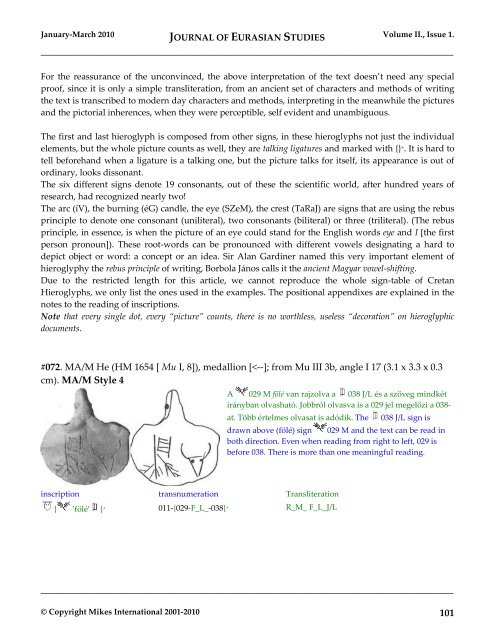EurasianStudies_0110..
EurasianStudies_0110..
EurasianStudies_0110..
Create successful ePaper yourself
Turn your PDF publications into a flip-book with our unique Google optimized e-Paper software.
January-March 2010 JOURNAL OF EURASIAN STUDIES Volume II., Issue 1.<br />
_____________________________________________________________________________________<br />
For the reassurance of the unconvinced, the above interpretation of the text doesn’t need any special<br />
proof, since it is only a simple transliteration, from an ancient set of characters and methods of writing<br />
the text is transcribed to modern day characters and methods, interpreting in the meanwhile the pictures<br />
and the pictorial inherences, when they were perceptible, self evident and unambiguous.<br />
The first and last hieroglyph is composed from other signs, in these hieroglyphs not just the individual<br />
elements, but the whole picture counts as well, they are talking ligatures and marked with {} + . It is hard to<br />
tell beforehand when a ligature is a talking one, but the picture talks for itself, its appearance is out of<br />
ordinary, looks dissonant.<br />
The six different signs denote 19 consonants, out of these the scientific world, after hundred years of<br />
research, had recognized nearly two!<br />
The arc (íV), the burning (éG) candle, the eye (SZeM), the crest (TaRaJ) are signs that are using the rebus<br />
principle to denote one consonant (uniliteral), two consonants (biliteral) or three (triliteral). (The rebus<br />
principle, in essence, is when the picture of an eye could stand for the English words eye and I [the first<br />
person pronoun]). These root-words can be pronounced with different vowels designating a hard to<br />
depict object or word: a concept or an idea. Sir Alan Gardiner named this very important element of<br />
hieroglyphy the rebus principle of writing, Borbola János calls it the ancient Magyar vowel-shifting.<br />
Due to the restricted length for this article, we cannot reproduce the whole sign-table of Cretan<br />
Hieroglyphs, we only list the ones used in the examples. The positional appendixes are explained in the<br />
notes to the reading of inscriptions.<br />
Note that every single dot, every “picture” counts, there is no worthless, useless “decoration” on hieroglyphic<br />
documents.<br />
#072. MA/M He (HM 1654 [ Mu I, 8]), medallion [

















